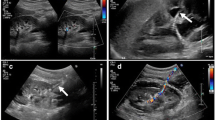Abstract
Objectives
To evaluate the effectiveness of ultrasonography and to determine whether ionizing radiation is necessary in the postoperative follow-up of children undergoing ureteroscopy.
Methods
We reviewed the charts of 49 children who underwent 51 ureteroscopic procedures for ureteral calculi. Renal ultrasound and intravenous urography were performed in all patients at 3 months after surgery for postoperative evaluation.
Results
In three cases, stones migrated to the kidney. Retrograde intrarenal surgery was performed in two patients and one patient required shockwave lithotripsy to become stone-free. Fourty-six children were completely stone-free and 3 had residual fragments on plain film in the postoperative 3 month. The sensitivity, specificity, negative and positive predictive values of ultrasonography for detecting hydronephrosis were 85.7, 100, 97.7 and 100%, respectively. Two patients under observation and three patients under medical expulsive therapy had resolution of hydronephrosis on follow-up. One patient required ureteroscopy for residual obstructing fragments.
Conclusions
Ultrasonography has limited accuracy for detecting residual ureteral stones, but it is a highly specific and reasonably sensitive test for detecting hydronephrosis. A combination of ultrasonography and plain film is a safe and effective imaging procedure in postoperative follow-up of children undergoing ureteroscopy.
Similar content being viewed by others
References
Jaidane M, Hidoussi A, Slama A et al (2010) Factors affecting the outcome of ureteroscopy in the management of ureteral stones in children. Pediatr Surg Int 26:501–504
Karadag MA, Tefekli A, Altunrende F et al (2008) Is routine radiological surveillance mandatory after uncomplicated ureteroscopic stone removal? J Endourol 22:261–266
Smith RC, Levine J, Rosenfeld AT et al (1999) Helical CT of urinary tract stones. Epidemiology, origin, pathophysiology, diagnosis, and management. Radiol Clin North Am 37:911–952
Jackman SV, Potter SR, Regan F et al (2000) Plain abdominal x-ray versus computerized tomography screening: sensitivity for stone localization after nonenhanced spiral computerized tomography. J Urol 164:308–310
Adiyat KT, Meuleners R, Monga M et al (2009) Selective postoperative imaging after ureteroscopy. Urology 73:490–493
Weizer AZ, Auge BK, Silverstein AD et al (2002) Routine postoperative imaging is important after ureteroscopic stone manipulation. J Urol 168:46–50
Bugg CE, El-Galley R, Kenney PJ et al (2002) Follow-up functional radiographic studies are not mandatory for all patients after ureteroscopy. Urology 59:662–667
Manger JP, Mendoza PJ, Babayan RK et al (2009) Use of renal ultrasound to detect hydronephrosis after ureteroscopy. J Endourol 23:1399–1402
McAchran SE, Dogra V, Resnick MI (2005) Office urologic ultrasound. Urol Clin North Am 32:337–352
Ellenbogen PH, Scheible FW, Talner LB et al (1978) Sensitivity of gray scale ultrasound in detecting urinary tract obstruction. Am J Roentgenol 130:731–733
Van Savage JG, Palanca LG, Andersen RD et al (2000) Treatment of distal ureteral stones in children: similarities to the American Urological Association guidelines in adults. J Urol 164:1089–1093
Smaldone MC, Corcoran AT, Docimo SG et al (2009) Endourological management of pediatric stone disease: present status. J Urol 181:17–28
Lam JS, Greene TD, Gupta M (2002) Treatment of proximal ureteric calculi: holmium: YAG laser ureterolithotripsy versus ESWL. J Urol 167:1972–1976
Desai M (2005) Endoscopic management of stones in children. Curr Opin Urol 15:107–112
Geavlete P, Georgescu D, Nita G et al (2006) Complications of 2735 retrograde semirigid ureteroscopy procedures: a single-center experience. J Endourol 20:179–185
Cheung MC, Leung YL, Wong BBW et al (2002) Prospective study on ultrasonography plus plain radiography in predicting residual obstruction after extracorporeal shock wave lithotripsy for ureteral stones. Urology 59:340–343
Brenner DJ, Elliston CD (2004) Estimated radiation risks potentially associated with full-body CT screening. Radiology 232:735–738
Brenner D, Elliston C, Hall E et al (2001) Estimated risks of radiation-induced fatal cancer from pediatric CT. AJR 176:289–296
Catalano O, Nunziata A, Altei F et al (2002) Suspected ureteral colic: primary helical CT versus selective helical CT after unenhanced radiography and sonography. AJR 178:379–387
Karod JW, Danella J, Mowad JJ (1999) Routine radiologic surveillance for obstruction is not required in asymptomatic patients after ureteroscopy. J Endourol 13:433–437
Beiko DT, Beasley KA, Koka PK et al (2003) Upper tract imaging after ureteroscopic holmium: YAG laser lithotripsy: when is it necessary? Can J Urol 10:2062–2067
Baumgartner BR, Steinberg HV, Ambrose SS et al (1987) Sonographic evaluation of renal stones treated by extracorporeal shock wave lithotripsy. Am J Roentgenol 149:131–135
Author information
Authors and Affiliations
Corresponding author
Rights and permissions
About this article
Cite this article
Resorlu, B., Kara, C., Resorlu, E.B. et al. Effectiveness of ultrasonography in the postoperative follow-up of pediatric patients undergoing ureteroscopic stone manipulation. Pediatr Surg Int 27, 1337–1341 (2011). https://doi.org/10.1007/s00383-011-2979-0
Accepted:
Published:
Issue Date:
DOI: https://doi.org/10.1007/s00383-011-2979-0




